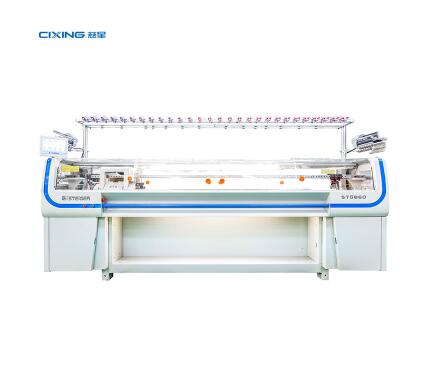The Role of Computerized Flat Knitting Machines in Fashion Design
2024-09-21
The fashion industry is constantly evolving, and one of the technological advancements shaping modern fashion is the computerized flat knitting machine. These machines have revolutionized how designers and manufacturers create knitwear, enabling precision, efficiency, and creativity that was previously unattainable. In this blog, we will explore the crucial role computerized flat knitting machines play in fashion design and how they are transforming the industry.

What is a Computerized Flat Knitting Machine?
A computerized flat knitting machine is a piece of equipment that automates the knitting process, producing flat fabrics that can be used for garments, accessories, or other textile products. Unlike manual knitting, which requires significant time and effort, these machines can be programmed to produce intricate patterns, shapes, and textures with incredible precision.
The machine works by manipulating individual needles across a flat bed, and with the help of computer software, designers can create complex designs, control the knitting process, and customize the knit structure, stitch types, and color variations.
Key Benefits of Computerized Flat Knitting Machines in Fashion Design
1. Enhanced Precision and Accuracy
Computerized flat knitting machines offer unmatched precision in terms of stitch accuracy, tension control, and pattern creation. Designers can use specialized software to input detailed design patterns, which are then executed by the machine with incredible accuracy. This precision is crucial for high-end fashion where every stitch and detail matters, ensuring a consistent and flawless final product.
2. Faster Production with Less Labor
Traditional knitting requires skilled labor and can be time-consuming, especially when producing complex garments. In contrast, computerized knitting machines can significantly reduce production time by automating the knitting process. This allows designers and manufacturers to create garments faster, responding to trends more quickly, and reducing lead times. Moreover, it minimizes the need for manual labor, resulting in lower production costs and greater scalability.
3. Design Flexibility and Customization
One of the most exciting aspects of computerized flat knitting machines is the vast range of design possibilities they offer. Designers can experiment with various stitch types, textures, and shapes that were once difficult to achieve by hand. These machines allow for the customization of each garment, offering endless possibilities for patterns, jacquards, intarsias, and 3D structures. This flexibility empowers designers to push the boundaries of creativity and innovation in knitwear design.
4. Sustainability and Waste Reduction
Sustainability is becoming increasingly important in the fashion industry, and computerized flat knitting machines play a key role in promoting eco-friendly practices. Traditional garment manufacturing can produce a large amount of waste due to fabric offcuts and excess material. However, with computerized knitting, garments can be knitted to shape (also known as seamless knitting or fully-fashioned knitting), meaning there is little to no waste generated during production. This process significantly reduces fabric waste, supporting the industry's shift towards more sustainable practices.
5. Versatility Across Various Applications
These machines are versatile and can produce a wide range of knitwear, from simple garments like sweaters and scarves to complex, fashion-forward pieces. Designers can use them to create both lightweight, delicate fabrics for spring collections and thick, durable knits for winter wear. Furthermore, computerized flat knitting machines are widely used for producing functional textiles, including sportswear, medical textiles, and smart fabrics with integrated technology.
The Impact on Fashion Design
The introduction of computerized flat knitting machines has had a profound impact on fashion design, reshaping how designers approach knitwear. With more control over the knitting process, designers can focus on innovation, combining new textures, colors, and shapes in ways that were once limited by manual knitting techniques. The speed and efficiency of these machines also align with the demands of fast fashion, allowing brands to quickly produce new styles and stay ahead of trends.
Furthermore, computerized flat knitting has enabled the development of 3D knitting, where garments are knitted three-dimensionally in a single piece, reducing the need for seams and enhancing comfort and fit. This has opened up new possibilities in both high-fashion and functional clothing, offering better quality, flexibility, and durability.
Challenges and Considerations
While computerized flat knitting machines offer numerous advantages, there are some challenges to consider. The upfront cost of the machines and the software can be a significant investment for smaller fashion brands or independent designers. Additionally, mastering the technology requires training, and not all designers are familiar with the intricacies of computerized knitting software. However, as the technology becomes more widespread and accessible, these barriers are expected to diminish.
Conclusion
The rise of computerized flat knitting machines has had a transformative effect on the fashion industry. From enabling intricate designs to reducing waste and improving production speed, these machines have expanded the creative potential of fashion designers while aligning with modern demands for sustainability and efficiency. As the technology continues to evolve, computerized knitting will likely play an even more pivotal role in shaping the future of fashion, driving innovation, and redefining the possibilities of knitwear design.


